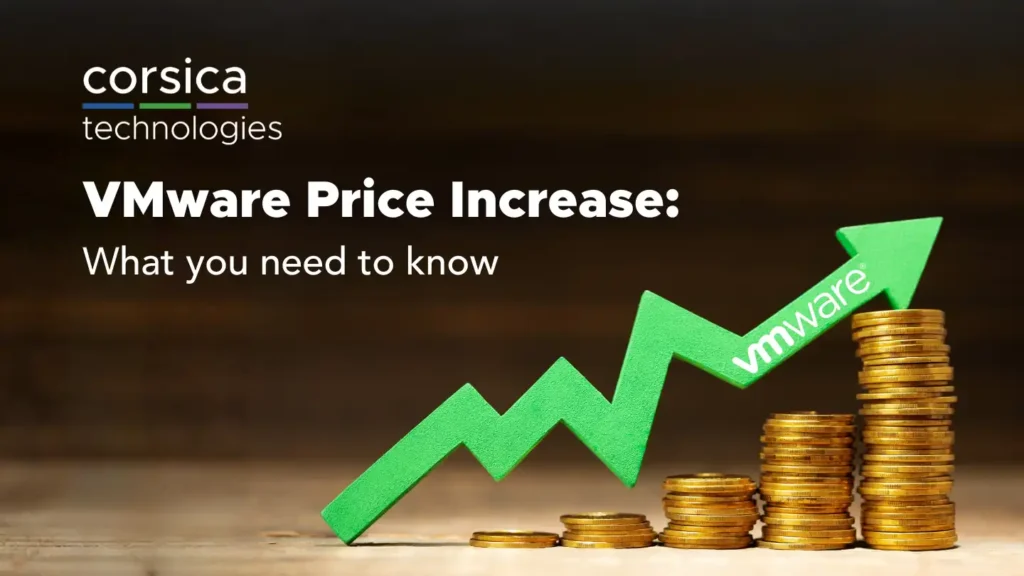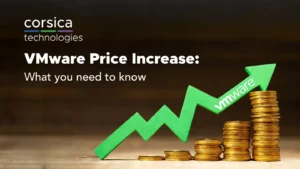In April 2025, VMware introduced significant alterations to their pricing structure. The changes have affected all customers and all products. Broadcom has responded to initial backlash, and the situation may continue to evolve. However, customers should plan on some form of altered pricing becoming permanent.
Many Corsica clients have already adapted to the changes as they stand today, but we’re working with others to determine the best path forward. Regardless of your use cases, your budget, or your strategic priorities, there’s a lot to know as you navigate virtualization in this new market landscape.
We’ve got all the details in this post—PLUS VMware cost optimization tactics and alternative technologies.
Key takeaways:
- VMware’s price increase is driven by a new subscription-based model and a new 72-core minimum purchase (per product or order line) coupled with per-core licensing.
- Low-core CPUs will generate the most significant price increases for customers of all sizes.
- Core consolidation is the best way to optimize costs while sticking with VMware.
- Microsoft Hyper-V and other options provide helpful alternatives where VMware is no longer a fit.
What is the VMware price increase?
Broadcom acquired VMware in 2023. That transaction has led to a shift in VMware’s pricing model starting in 2025. There are several significant changes to VMware’s licensing.
- Subscription-based licensing has replaced perpetual licensing. Customers must now pay recurring fees for VMware products rather than making a one-time purchase and owning the software license perpetually.
- Customers can’t purchase fewer than 72 licenses. VMware’s previous minimum license count was 16, but now customers must buy licenses for at least 72 cores. (Note that the required minimum 16 cores per CPU has not changed, only the minimum license count per product or order line.)
- Customers must pay a 20% fee for late renewals. While VMware always had a late renewal fee in place, it has increased to 20%.
- VMware has consolidated its catalog to fewer, bundled offerings. These bundles are not flexible, meaning customers must pay for every product or feature included in a given bundle.
- Software is now licensed per core, with a minimum of 16 cores per CPU. Customers will be billed for 16 cores per CPU even if their CPU has fewer cores.
How is the VMware price increase affecting customers?
Every VMware customer is affected by these changes. While customers of all sizes are experiencing technical effects, smaller customers may also experience significant financial effects.
Here are some of the largest impacts we’re seeing among clients.
Impact on SMBs and midmarket
VMware has retired the Essentials Plus Kit, a bundle that gave SMBs and midmarket companies access to sophisticated features at a lower price point.
VMware’s new 16-core minimum also impacts smaller businesses with lower CPU usage, forcing them to pay for 16 cores per CPU whether they have 16 or not.
Impact on enterprise customers
Enterprise customers may feel similar impacts as smaller companies, including reduced flexibility in product bundling and the impact of the 72-core minimum requirement per CPU. This will be especially true for enterprise customers that have a large number of CPUs with a low number of cores per CPU, as customers are now forced to pay for 72 cores per CPU whether they have that many or not.
How will the 72-core minimum affect my small servers?
Unfortunately, small servers will see the largest impact from VMware’s new 72-core licensing minimum. New orders require licensing at least 72 cores per product, with the 16 core per CPU minimum still in effect.
This will affect several types of use cases.
- Small businesses
- Branch offices
- Edge CPUs
- Any use case in which fewer cores are distributed over more servers

Can we negotiate or grandfather existing VMware contracts?
Theoretically, yes. VMware may negotiate with a customer for short-term pricing to make the transition easier. In most cases, however, and for most customers, it’s unlikely that VMware will budge on their new pricing policies. Companies should enter negotiations with a well-defined BATNA (best alternative to a negotiated agreement).
Is Corsica Technologies still a VMware reseller?
No. Broadcom restructured its partner program, requiring existing resellers to reapply under more restrictive criteria. Like many MSPs, Corsica Technologies will no longer be a reseller going forward. We can help our clients connect with another reseller, but we cannot sell directly.
Are there alternatives to VMware that have lower licensing costs?
There are several alternatives to VMware that may present lower costs in specific use cases. Here are some of the leading providers.
- Microsoft Hyper-V is built into Windows Server, and it’s a great choice for Microsoft customers.
- Nutanix is a great provider for hyperconverged infrastructure (HCI).
- Proxmox VE offers open-source virtualization and web-based management.
- OpenStack is another open-source option that’s highly customizable.
- Oracle VM is a great option for companies that use Oracle products.
How complicated is it to migrate from VMware to an alternative?
In most cases, migrating off of VMware is a complex project requiring significant planning and coordination. While the licensing costs for an alternative solution may be lower, the migration project will create its own costs, which aren’t insignificant. Switching providers also has the potential to disrupt operations, as it’s essentially a server migration.
In some cases, migrating off VMware may be justified. In others, it may not be worth the cost and effort. If you’re unsure, we’re happy to help you determine the best path forward for your organization. Just reach out to us.
How can we optimize costs while keeping VMware?
For many customers, VMware may still be the best option. Switching to another provider may create too much pain or operational impact, or VMware may have essential features on which the business depends.
Whatever the reason, there are several ways to optimize costs while retaining VMware products.
- Right-size your environment. Audit your virtual machine usage and eliminate over-provisioning. Try to consolidate workloads onto fewer, higher-density servers to maximize the vale of your core licenses.
- Pick the right bundle. If you don’t need advanced networking or storage features, choose vSphere Foundation (VVF) rather than VMware Cloud Foundation (VCF). This way, you don’t pay for extras like NSX or vSAN.
- Negotiate the longest contract you can afford at today’s pricing. This will lock you in and protect you against price increases.
- Consider VMware Cloud Services. VMware Cloud on a major cloud platform can simplify your VMware licensing. Of course, the use case needs to be a good fit for the cloud beyond the potentially beneficial licensing.
- Optimize your core count. If you have nine servers today, each with eight cores, can you consolidate those into one server with 72 cores? It won’t be possible in all cases, but applying this principle can align your VM architecture with VMware’s new pricing rules.
- Offload non-critical workloads to non-VMware environments. For example, try running Microsoft Hyper-V on dev or test environments while keeping VMware on production environments.
The takeaway: Do your homework and understand your priorities
While VMware’s pricing changes are significant, they don’t have to disrupt your business. The key is to understand your virtualization requirements, understand VMware’s new pricing policies, and choose the best way forward for your organization. Here at Corsica Technologies, we’ve helped 1,000+ clients solve their business problems through technology. Contact us today, and let’s figure out the right virtualization strategy for your organization.

Want to learn more about VMware pricing and alternatives?
Reach out to schedule a consultation with our server specialists.













